Volume 12: No. 1, 2023
Previous issue | Next issue | Archive
Volume 13 (3); September 25, 2023
Review
A Review on Production, Reproduction, Morphometric, and Morphological Characteristics of Ethiopian Native Chickens
Mekonnen KT, Lee D-H, Cho Y-G, and Seo K-S.
J. World Poult. Res. 13(3): 280-291, 2023; pii: S2322455X2300031-13
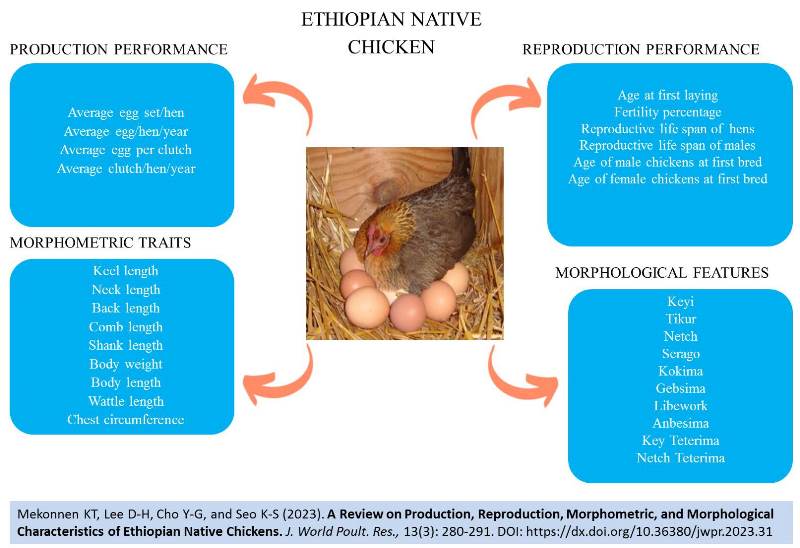 DOI: https://dx.doi.org/10.36380/jwpr.2023.31
DOI: https://dx.doi.org/10.36380/jwpr.2023.31
ABSTRACT: Native chickens in Ethiopia are characterized in a fragmented manner for their performance characteristics and genotypes. This review aimed to explore the production and reproduction performance characteristics as well as the morphometric and morphological diversity of Ethiopian native chickens. The investigation was performed on four production performance characteristics, including average egg per clutch, average clutch/hen/year, average egg set/hen, and average egg/hen/year, as well as six reproductive performance characteristics, including age at first laying, age of male chickens at first bred, age at which female chickens are first bred, the reproductive life span of males and females, and fertility percentage in various parts of Ethiopia. Some economically practical morphometric characteristics of native chickens, such as shank length, chest circumference, comb length, body weight, body length, keel length, wattle length, neck length, back length, and morphological diversity, were also summarized. Regarding performance characteristics, there were some variations in eggs’ average production performance per clutch (13.56-15.4 eggs) and clutch/hen/year (3.0-4.29) in Ethiopia. The average reproduction performance characteristics of Ethiopian native chickens for age at first laying (6.90-7.13 months), age of male chickens at first bred (5.87-6.15 months), female at first bred (5.20-5.93 months), the reproductive life span of males (3.79 years) and hens (3.56 years), and chicks hatched from set eggs revealed variation across Ethiopia. In various locations of Ethiopia, the average trait values reported for Ethiopian native chickens under the farmer’s management differed in terms of morphometric and morphological features. The variation observed in performance characteristics, as well as morphometrics and morphological characteristics for Ethiopian native chicken ecotype population, can help the native breed classification, unique trait conservation, and breed improvement intervention programs.
Keywords: Ethiopia, Morphological trait, Morphometric trait, Native chicken, Performance
[Full text-PDF] [Crossref Metadata] [Scopus] [Export from ePrint] [How to Cite]
|
https://badge.dimensions.ai/badge.js" charset="utf-8"> |
https://plu.mx/plum/a/?doi=10.36380/jwpr.2023.32" data-popup="right" data-size="large" data-site="plum" data-hide-when-empty="true">Antioxidant Properties and Toxic Risks of Using Metal Nanoparticles on Health and Productivity in Poultry |
Review
Antioxidant Properties and Toxic Risks of Using Metal Nanoparticles on Health and Productivity in Poultry
Naumenko S, Koshevoy V, Matsenko O, Miroshnikova O, Zhukova I, and Bespalova I.
J. World Poult. Res. 13(3): 292-306, 2023; pii: S2322455X2300032-13
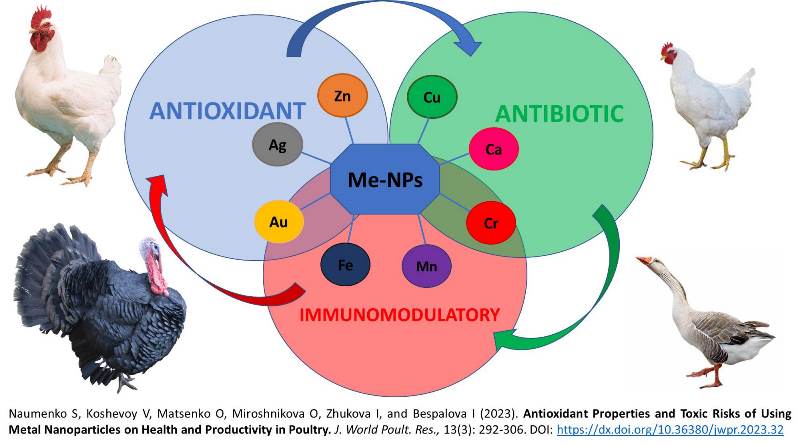 DOI: https://dx.doi.org/10.36380/jwpr.2023.32
DOI: https://dx.doi.org/10.36380/jwpr.2023.32
ABSTRACT: Metal nanoparticles (NPs) are introduced into various fields of science, particularly poultry farming. Supplementation of metal salts in nanoform can increase the profitability of poultry farming by enhancing meat and egg production. Although their toxic parameters pose limitations on their use, many studies have evaluated the effects of using metal NPs in modern poultry farming on health, productivity, metabolism, and especially antioxidant properties. In addition, the peculiarities of their toxicokinetic and recommended doses that meet safety criteria in practical activities are highlighted. Zinc oxide NPs are one of the most studied compounds in the poultry industry. Their pronounced antioxidant properties, positive effect on productivity and homeostasis of poultry, egg quality, and immune status have been experimentally confirmed. Copper oxide NPs have similar properties but are limited in usage due to their toxicokinetics. Silver and gold NPs emerge as potential alternatives to antibiotics and could solve the resistance problem of microorganisms to antibiotics. Other important NPs used in poultry are Iron and Calcium. In their nanoform, these NPs exhibit high bioavailability, which allows for efficient absorption and utilization by poultry. The methods used to synthesize these nanoparticles make it economically viable to incorporate them into poultry diets, reducing overall expenses compared to similar macroergic compounds. Manganese and chromium NPs positively affect sperm survival in turkeys during refrigerated storage and contribute to increasing the resistance of the broiler chickens' body to heat stress and normalizing the metabolism of sex hormones. In conclusion, the application of metal nanoparticles to poultry is a promising research direction, aiming at the development of feed additives, antibiotics, and growth stimulants due to their antioxidant, bactericidal, and immunomodulatory effects.
Keywords: Antioxidants, Health, Metal Nanoparticles, Poultry, Productivity, Toxicology
[Full text-PDF] [Crossref Metadata] [Scopus] [Export from ePrint] [How to Cite]
|
https://badge.dimensions.ai/badge.js" charset="utf-8"> |
https://plu.mx/plum/a/?doi=10.36380/jwpr.2023.33" data-popup="right" data-size="large" data-site="plum" data-hide-when-empty="true">Effects of Dietary Supplementation of Lactobacillus farciminis and Lactobacillus rhamnosus on Growth and Production Indicators of Broiler Chickens |
Research Paper
Effects of Dietary Supplementation of Lactobacillus farciminis and Lactobacillus rhamnosus on Growth and Production Indicators of Broiler Chickens
Eglite S, Mancevica L, and Ilgaza A.
J. World Poult. Res. 13(3): 307-316, 2023; pii: S2322455X2300033-13
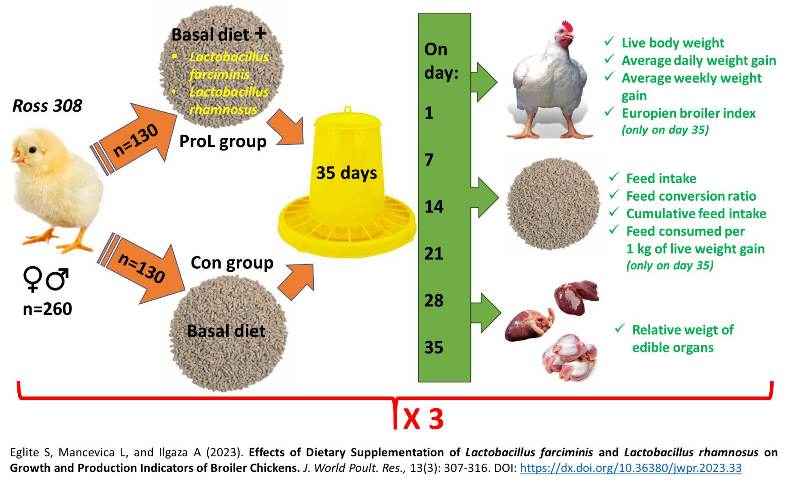 DOI: https://dx.doi.org/10.36380/jwpr.2023.33
DOI: https://dx.doi.org/10.36380/jwpr.2023.33
ABSTRACT: In response to the 2006 EU ban on the use of antibiotics as growth promoters, researchers have sought alternatives, leading to a focus on the beneficial effects of probiotics on chickens. The aim of this study was to evaluate the effect of the probiotic mixture containing Lactobacillus (L.) farciminis CNCM-I-3699 and Lactobacillus rhamnosus CNCM-I-3698 on the growth, production indicators, and edible organs of broiler chickens. Three trials were conducted, each consisting of 260 newly hatched Ross 308 broiler chicks (males and females) from a commercial hatchery, randomly allocated into control (n = 130) and probiotic-supplemented groups (n = 130). The dietary treatments were basal diet for the control group and basal diet + the mixture of L. farciminis CNCM-I-3699 (2.1010 GU/g) and L. rhamnosus CNCM-I-3698 (2.1010 GU/g) at a rate of 4g/10kg of diet for the probiotic supplemented group. Broilers were raised until day 35 of age, and their body weight and feed intake were recorded on days 1, 7, 14, 21, 28, and 35. All broiler chickens were weighed on the first day. The investigated parameters included average weight gain, feed conversion ratio, cumulative feed intake, and the European Broiler Index. Daily mortality was recorded. The average organ’s relative weight was calculated for each group on days 1, 7, 14, 21, 28, and 35. Although both groups yielded positive results regarding growth and production indicators, no significant differences were observed between the two groups, suggesting that probiotics may not provide expected outcomes when appropriate conditions and age-related requirements are met. The probiotic-supplemented group exhibited significantly accelerated growth in the heart and liver. However, relative organ weights did not differ significantly between the groups.
Keywords: Body weight, Edible organs, Poultry, Probiotic, Productivity
[Full text-PDF] [Crossref Metadata] [Scopus] [Export from ePrint] [How to Cite]
|
https://badge.dimensions.ai/badge.js" charset="utf-8"> |
https://plu.mx/plum/a/?doi=10.36380/jwpr.2023.34" data-popup="right" data-size="large" data-site="plum" data-hide-when-empty="true">Effects of Supplementation of Saviotan Feed (Chestnut Tannin) on Blood Parameters and Yolk Cholesterol Concentration in Japanese Quails (Coturnix japonica) |
Research Paper
Effects of Supplementation of Saviotan Feed (Chestnut Tannin) on Blood Parameters and Yolk Cholesterol Concentration in Japanese Quails (Coturnix japonica)
Erwan E, Afriadi, Rodiallah M, Irfan I, and Ibrah W.
J. World Poult. Res. 13(3): 317-322, 2023; pii: S2322455X2300034-13
 DOI: https://dx.doi.org/10.36380/jwpr.2023.34
DOI: https://dx.doi.org/10.36380/jwpr.2023.34
ABSTRACT: Tannins are secondary metabolites and active compounds widely present in plants. Tannins have several properties, such as astringent, antiparasitic, anti-diarrheal, anti-bacterial, and antioxidant. Hence, plants containing tannins are a major study subject for a natural alternative to in-feed antibiotics or antioxidants. The functions of tannin extracted from chestnut wood, namely Saviotan Feed (SF) in poultry, especially in quails, have not yet been fully understood. The current study aimed to examine the effect of SF supplementation on some plasma metabolites, including glucose (GLU), triglyceride (TG), total cholesterol (TCHO) concentration, and yolk cholesterol in quails (Coturnix japonica). A total of 100 unsexed quails were divided into 4 groups, with 25 quails in each group. These quails were then placed into 20 experimental pens, with 5 quails per pen. Each treatment was replicated 5 times, and the quails were fed a commercial rations diet supplemented with different SF doses of 0% (control), 0.1%, 0.2%, and 0.3%. Quails were provided with SF supplementation from 14 to 56 days of age. A sample of 40 plasma and eggs were randomly collected and analyzed for GLU, TG, and TCHO. The results indicated no significant effects of SF on plasma GLU and TG concentration, but a significant effect was found regarding TCHO. Moreover, supplementation of SF from 0.1 to 0.3% significantly decreased TCHO concentration in the yolk. In conclusion, it has been determined that supplementation of SF may play a significant role in decreasing TCHO in yolk eggs in quails.
Keywords: Chestnut tannins, Cholesterol, Glucose, Japanese quail, Plasma metabolites, Triglycerides
[Full text-PDF] [Crossref Metadata] [Scopus] [Export from ePrint] [How to Cite]
|
https://badge.dimensions.ai/badge.js" charset="utf-8"> |
https://plu.mx/plum/a/?doi=10.36380/jwpr.2023.35" data-popup="right" data-size="large" data-site="plum" data-hide-when-empty="true">Design and Analysis of Ventilation System for Closed Poultry House in Tropical Climate Conditions |
Research Paper
Design and Analysis of Ventilation System for Closed Poultry House in Tropical Climate Conditions
Saner KA and Shekhawat SP.
J. World Poult. Res. 13(3): 323-331, 2023; pii: S2322455X2300035-13
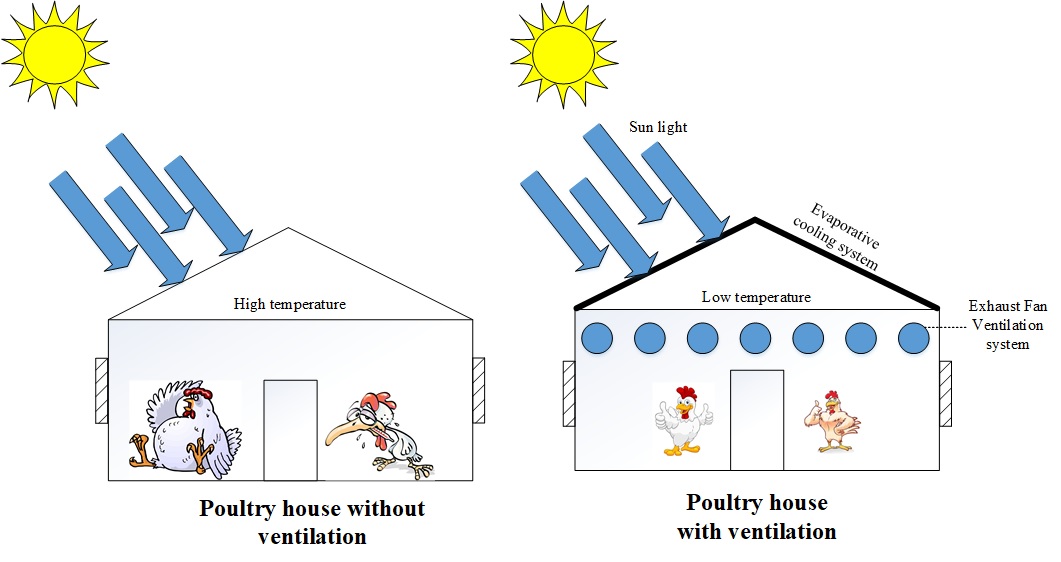 DOI: https://dx.doi.org/10.36380/jwpr.2023.35
DOI: https://dx.doi.org/10.36380/jwpr.2023.35
ABSTRACT: The climate significantly impacts the temperature in different parts of the world. A moderate environment makes it simple to construct a chicken farm. Nevertheless, raising the birds in tropical places where typical temperatures can exceed 40-45°C is difficult because they can only survive at temperatures between 30°C and 35°C. As a result, the current study aimed to design a chicken house with a ventilation and cooling system to prevent excessive heat. The effectiveness of ventilation systems in maintaining liveable and constant conditions at the chicken house was assessed using computational fluid dynamics modeling to mimic internal and external airflows. In this study, a water evaporator-based cooling system and an exhaust fan-based ventilation system were built within a poultry house. ANSYS CFD was utilized to create the design and examine the flow of the model. The findings of each model were generated individually, and these results were compared to those of the other models to determine which model could decrease the temperature within the chicken coop. The proposed model's maximum temperature was around 30-32°C. A poultry house can be constructed using this idea to maintain chickens at a suitable temperature range of 30-32°C.
Keywords: Computational fluid dynamic, Evaporator, Exhaust fan, Poultry house, Ventilation
[Full text-PDF] [Crossref Metadata] [Scopus] [Export from ePrint] [How to Cite]
|
https://badge.dimensions.ai/badge.js" charset="utf-8"> |
https://plu.mx/plum/a/?doi=10.36380/jwpr.2023.36" data-popup="right" data-size="large" data-site="plum" data-hide-when-empty="true">Effects of Partnership Patterns on Broiler Chickens’ Performance in the Agribusiness System of Indonesia |
Research Paper
Effects of Partnership Patterns on Broiler Chickens’ Performance in the Agribusiness System of Indonesia
Febrianto N, Akhiroh P, Helmi M, and Hartono B.
J. World Poult. Res. 13(3): 332-341, 2023; pii: S2322455X2300036-13
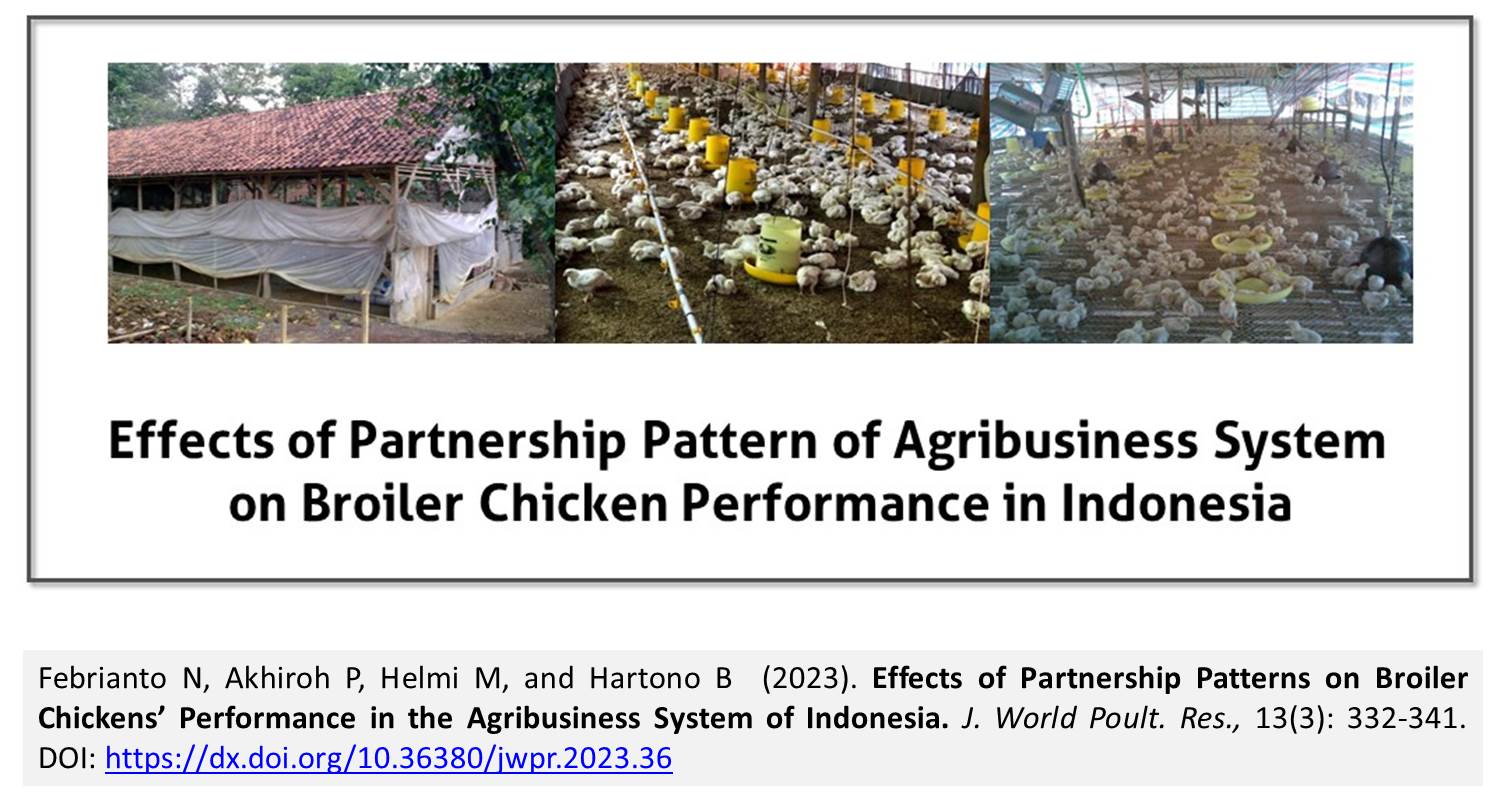 DOI: https://dx.doi.org/10.36380/jwpr.2023.36
DOI: https://dx.doi.org/10.36380/jwpr.2023.36
ABSTRACT: The partnership system is standard broiler cooperation in Indonesia. This system influenced agribusiness performance. Hence, the current study aimed to analyze the broiler agribusiness system in Kediri Regency, Indonesia, addressing three main areas, including partnership patterns, production performance, and financial performance. In this study, data was gathered from participants using a cross-sectional survey approach, capturing information from individuals at a specific moment in time. The research was performed from July to September 2022, utilizing both primary and secondary data. Primary data was obtained through direct observations and interviews with relevant stakeholders, while secondary data was sourced from various databases, such as the Indonesian Statistical Bureau and the Agriculture Ministry of Indonesia. Both types of data were subjected to quantitative descriptive analysis. The results indicated that the broiler partnership pattern consisted of three subsystems, including the chicken production facility providers (day-old chicks, feed, and medicines), the farming unit responsible for production process management (housing, feeding, drinking, and biosecurity), and the marketing subsystem focusing on chicken prices). The farmers in the farming unit showed effective production performance with a feed conversion ratio of 1.69, an index performance of 307, and an average body weight of 2.03 kg/head. Moreover, the farmers demonstrated a profitable financial performance with the revenue-cost ratio exceeding 1, reaching 1.07.
Keywords: Agribusiness, Broiler, Income, Partnership, Profitable, Revenue
[Full text-PDF] [Crossref Metadata] [Scopus] [Export from ePrint] [How to Cite]
|
https://badge.dimensions.ai/badge.js" charset="utf-8"> |
https://plu.mx/plum/a/?doi=10.36380/jwpr.2023.37" data-popup="right" data-size="large" data-site="plum" data-hide-when-empty="true">Effects of Supplementation of Eurca Seeds as Nutraceutical Feed Additive on Productivity, Antioxidant Activity, and Yolk Cholesterol Level of Laying Hens |
Research Paper
Effects of Supplementation of Eurca Seeds as Nutraceutical Feed Additive on Productivity, Antioxidant Activity, and Yolk Cholesterol Level of Laying Hens
EL-Barbary AM, EL-Sahn AA, Iraqi EE, Elprollosy AA, Farag ME, and Khalifah A.
J. World Poult. Res. 13(3): 342-351, 2023; pii: S2322455X2300037-13
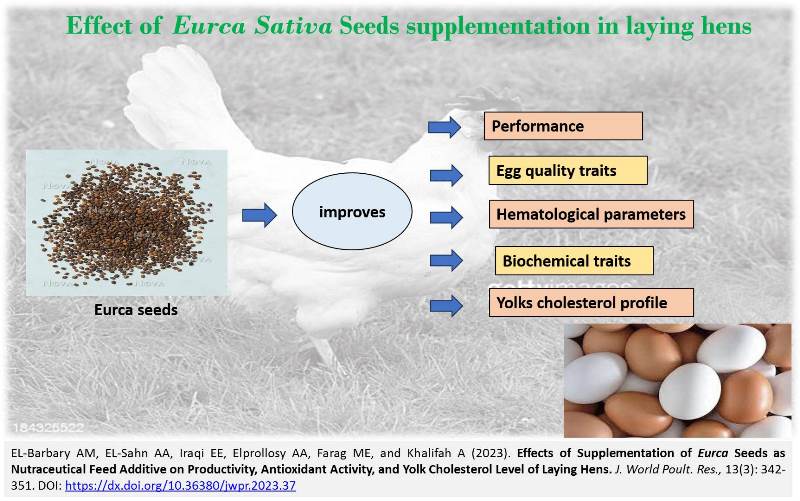 DOI: https://dx.doi.org/10.36380/jwpr.2023.37
DOI: https://dx.doi.org/10.36380/jwpr.2023.37
ABSTRACT: Eruca sativa (ES) seeds are annual herbs belonging to the Brassicaceae family, widely grown in Mediterranean countries, such as Egypt, Italy, and Greece. The ES is rich in macronutrient components and phytochemical content, exhibiting potent antioxidant properties and functional properties for vital processes such as digestion and absorption of nutrients. Therefore, this research was conducted to evaluate the effects of dietary ES supplementation on laying performance, some blood parameters, and egg yolk cholesterol. A total of 300 Silver Sabahia strain hens, aged 26 weeks, were randomly distributed among four groups of five replicates, each replicate consisting of 15 hens. Chickens in group 1 served as a control and were fed the basal diet. Those in groups 2, 3, and 4 were fed basal diet supplemented with 1, 2, and 3% ESs, respectively. Productive performance traits, egg quality traits, hematological parameters, blood parameters, and yolk cholesterol profiles were performed throughout the study. The study lasted for 13 weeks (until week 39 of chickens' age). Results indicated that 3% ES supplementation had higher results on egg mass (35.68%), egg production (21.13%), and improved feed conversion ratio by 30.37%, compared to all groups. Furthermore, ESs supplementation positively affects the shell thickness and yolk color score compared to the control. Compared to the control, the highest significant blood hemoglobin and lymphocytes were recorded in the groups supplemented with 2% and 3% of ESs. The ES inclusion at a higher level (3%) in the diet of laying hens led to significantly enhanced serum high-density lipoprotein and total antioxidant capacity, while reducing cholesterol, low-density lipoprotein, and malondialdehyde levels, compared to the control diet. Serum calcium, tri-iodothyronine, and alkaline phosphatase levels increased significantly in response to 3% ES treatment, while liver enzymes decreased significantly compared to the control diet. Notably, the addition of 2% and 3% ESs to the hens’ ration resulted in reduced egg cholesterol content, which is desirable for consumers seeking healthier dietary choices. Finally, adding 3% ESs to hens’ diet improves productive performance, egg quality traits, hematological parameters, blood parameters, and yolk cholesterol profile.
Keywords: Blood parameters, Egg production, Eruca seed, Nutraceutical additive, Yolk cholesterol
[Full text-PDF] [Crossref Metadata] [Scopus] [Export from ePrint] [How to Cite]
Previous issue | Next issue | Archive
This work is licensed under a Creative Commons Attribution 4.0 International License (CC BY 4.0).![]()
